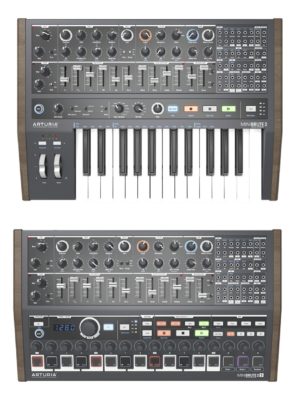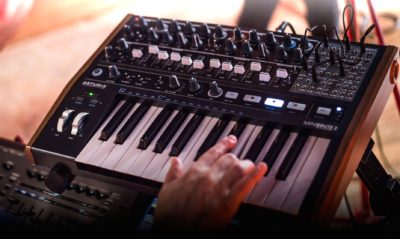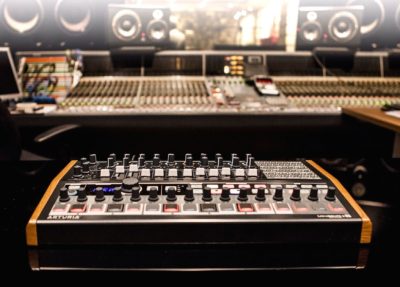New Gear Review: MiniBrute 2 & 2S by Arturia

Differentiated only by a keyboard and sequencer, Arturia’s fully-analog MiniBrute 2 & 2S aim to take your synthesis game to the next level.
The MiniBrute 2 and MiniBrute 2S by Arturia are analog synths that can be of use to beginners and power-users alike. For beginners, these machines can serve as semi-modular gateway synths, to enter into a broad world of modular synthesis, or for the power-users, deep and rich analog synths in their own right.
The sound of both units is pure analog, all the way through, with fantastic oscillators and filters. The builds are sturdy, with great knobs and faders, and a high-end plastic top casing. These are synths that feel like they can take a beating on the road and still stand strong. Not that you’d want to beat it (you’d better not), but the point is, it will survive a rigorous touring schedule.
Both synths are built upon the same engine, and the differences don’t emerge until you get deeper into exploring their performance and playing capabilities. For most of this review, we will treat the MiniBrute 2 and MiniBrute 2S as one synth, only separating them when features call for it. Now let’s dive in and see what they’re all about.
Features
The main difference between the MiniBrute 2 and 2S is the sequencer on the 2S and the keyboard on the 2. Otherwise, the two units are exactly the same. The MiniBrute 2 is a beast of a synth with two oscillators, one of which has an assortment of waveforms: Sawtooth, Square, Triangle, and Noise. The levels of these waveforms are adjusted using faders for each one. The second oscillator has three switchable waveforms: Sine, Sawtooth, and Square. In the first oscillator, along with the level mixer, the Square waveform has a dedicated Pulse-Width knob, with an attached Pulse-Width Modulation Amount knob, just to get freaky with. There is also an external input for twisting sounds from the outside world.
As if all that wasn’t enough, the saw has an ”Ultrasaw” knob that further sharpens the Sawtooth waveform, giving it extra bite. Besides this, there is also a Metalizer which affects the Triangle wave by folding it in on itself, taking its normally soft tone and twisting it out of proportion, giving you a monster-like harsh sound.
Each of the two units has a basic arpeggiator that does the job, and fans of arpeggiators will be happy with the results they can get. Two LFOs give you plenty of modulation power straight out of the box, and those, along with two envelopes (one is ADSR and the other is a smaller AD envelope) ensure that you have enough immediate flexibility.
Besides the oscillators and modulation sources, the MiniBrute 2 features a 2-pole, 12dB Steiner-Parker filter which can be set into one of four modes: Low-Pass, High-Pass, Band-Pass, or Notch. Modulation here includes Frequency or Resonance Modulation, and a third modulation source is included for extra weirdness.
The patch cable wonderland on the right of these synths is really what sets them apart and makes them semi-modular. If you’re familiar with the capabilities of the vintage Korg MS20 (or its modern sibling, the MS20-mini), then you’ll understand what semi-modular means. If those letters and numbers mean nothing to you, then here’s a quick rundown:
Modular synths have nothing hardwired, whereas semi-modular synths have certain connections and modulations pre-built, but they can be overridden by patch cables. This opens up tons more options. So, with the MiniBrute 2 and 2S, you get the best of both worlds. if you want to just take it out of the box and get going, you can, but on the other hand, if you want to go a little crazy and experiment with wacky connections, you can do that too.
One last feature which should be mentioned is that the MiniBrute 2 comes with a “Patch Cookbook.” This is a large, self-standing library of patches that can be programmed. Every knob, fader, and patch cable are listed for a variety of sounds that range from basses to leads, sound effects to pads, etc. It is a welcome addition that will have even beginners making usable sounds in no time.
In Use
As you can probably imagine with all of the features above, the MiniBrute 2 can create the entire backbone of a track. The low end is thick and heavy, making it a great go-to for deep bass tones. And once you start twisting those Metalizer and Ultrasaw knobs, the bass can quickly be transformed into a screaming lead.
This brings us to one of the biggest surprises with these units—just how much variety you can get out of them. Within the Patch Cookbook, there is a setting for creating a TB-303 kind of acid bass, which it does really well. From there you can easily patch a lovely pad sound, which—with the right outboard effects—can add a lush fill to your tracks, or even be the backbone for your next ambient masterpiece.
One of the reasons these synths are so great for beginners is because you can do so much with them without even inserting a single cable; a lot of the fun comes from exploring that right-hand patch cable wonderland. And if patching cables is not your thing (though it very well may be after a couple of sessions with these synths), then you can still accomplish amazing results with just the provided knobs and faders, and of course, modulation.
Oh, the filter. Let’s talk about that, shall we? People have written about the Steiner-Parker filter in many articles, but if you don’t know what that means, then here: unlike a Moog filter, it doesn’t lose its bite when you start cranking the resonance. And the resonance can be cranked a lot. The filter will easily self-oscillate when pushed high enough, which means that it can be used as another tone if set up correctly. It’s a great filter that sounds fantastic, and is “vary-capable” (a word I just made up, which means to have lot of color and variety).
The units feature a “Brute Factor” knob, which is kind of like an overdrive effect. That’s not exactly the right word because it’s not just a distortion, but it definitely fits in the same family. By turning the knob to the right, the harmonics start to perk up, and if you go too far you’ll end up with something unrecognizable, so use it with care. A little goes a long way here.
As mentioned above, the patch points on the right open up a myriad of sonic possibilities. But you have to know what you’re doing as there are no presets, there is no ”Randomize” button, and there is no undo function. There is the aforementioned Patch Cookbook, and there are online resources for learning the art of modular patching—but be prepared to struggle a bit more here than with a traditional modern digital synth.
The keyboard on the MiniBrute 2 feels great. In general, I feel that Arturia has been doing a great job with their keyboards, and this is no exception. The depth of action is nice, and the keys feel solid and strong, not cheap or brittle. If you opt for the MiniBrute 2S, the keys are replaced by pads that are both velocity and touch sensitive, which also feel great.
The sequencer on the 2S is a three-track, sixty-four step sequencer which can control pitch, gate, velocity, and pressure. This is an area where Arturia’s history and maturity shows: this sequencer is really easy to use. It is very much an analog-style sequencer, and through the patching section of the synth, you can use these defaults to change other parameters. Record and playback on the sequencer is fairly straightforward, and patterns can be easily saved and loaded. This is the closest to presets that these synths get.
Also, flipping between clock sync is straightforward. Just use the Sync button to flip through different sources: Internal, USB, MIDI, and (analog) Clock. No matter what gear you are syncing to (digital or analog), it is easy and straightforward to do so; there are no hidden menus at all.
One last thing that’s worth mentioning is the RackBrute, which is a case for EuroRack modules. While this is not part of the actual synths, and we didn’t have one to evaluate for this review, it is a cool idea for Arturia to provide a platform for crossing from the synth world into the modular world. Stylistically, it looks similar to the MiniBrute 2, so it keeps your studio or live setup consistent. But again, we can’t comment on the build quality here.
To Be Critical
It’s not really fair to criticize an analog synth for not having presets, but I do miss them here. Personally, I’m a preset guy. I like turning on a synth and exploring what others have made with it. I like being able to save my own presets and recall them without fuss. Although I don’t dislike this synth for its lack of presets, I do wish they were here.
One thing that should be mentioned is the absence of an effects section. There is no reverb or delay. There is nothing here to ”pretty up” the sound. So consider yourself warned: just in case you don’t know, there ya go.
Other than that, there is nothing that I can think of to knock these synths; they are beasts. You want a lead? It’s here. You need bass? Done. Craving weird textures? No problem. The only thing to factor in here is that the learning curve can be a bit steep, but I can say with confidence that these synths can be a really good entryway into the world of both modular and analog synthesis.
Oh wait… one last thing… longer patch cables! Arturia could definitely put some longer patch cables in the box, and I wouldn’t be mad about it.
Summing it Up
It’s no question that the MiniBrute 2 and MiniBrute 2S by Arturia are great analog synths, for both experts and beginners alike. Both units are priced the same at $699 street, and which one you should buy depends entirely on you and your unique needs.
If what you’re looking for is a great-sounding, fully-analog synth, then either of these will be a great purchase.
Please note: When you buy products through links on this page, we may earn an affiliate commission.








